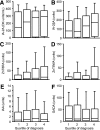Rising incidence of type 1 diabetes is associated with altered immunophenotype at diagnosis
- PMID: 22315309
- PMCID: PMC3282823
- DOI: 10.2337/db11-0962
Rising incidence of type 1 diabetes is associated with altered immunophenotype at diagnosis
Abstract
The incidence of type 1 diabetes has increased rapidly over recent decades, particularly in young children. We aimed to determine whether this rise was associated with changes in patterns of humoral islet autoimmunity at diagnosis. Autoantibodies to insulin (IAA), GAD (GADA), islet antigen-2 (IA-2A), and zinc transporter 8 (ZnT8A) were measured by radioimmunoassay in sera collected from children and young adults with newly diagnosed type 1 diabetes between 1985 and 2002. The influence of date of diagnosis on prevalence and level of autoantibodies was investigated by logistic regression with adjustment for age and HLA class II genetic risk. Prevalence of IA-2A and ZnT8A increased significantly over the period studied, and this was mirrored by raised levels of IA-2A, ZnT8A, and IA-2β autoantibodies (IA-2βA). IAA and GADA prevalence and levels did not change. Increases in IA-2A, ZnT8A, and IA-2βA at diagnosis during a period of rising incidence suggest that the process leading to type 1 diabetes is now characterized by a more intense humoral autoimmune response. Understanding how changes in environment or lifestyle alter the humoral autoimmune response to islet antigens should help explain why the incidence of type 1 diabetes is increasing and may suggest new strategies for preventing disease.
Figures

References
-
- Patterson CC, Dahlquist GG, Gyürüs E, Green A, Soltész G; EURODIAB Study Group Incidence trends for childhood type 1 diabetes in Europe during 1989-2003 and predicted new cases 2005-20: a multicentre prospective registration study. Lancet 2009;373:2027–2033 - PubMed
-
- Gillespie KM, Bain SC, Barnett AH, et al. The rising incidence of childhood type 1 diabetes and reduced contribution of high-risk HLA haplotypes. Lancet 2004;364:1699–1700 - PubMed
-
- Gale EA. Spring harvest? Reflections on the rise of type 1 diabetes. Diabetologia 2005;48:2445–2450 - PubMed
-
- Yu L, Rewers M, Gianani R, et al. Antiislet autoantibodies usually develop sequentially rather than simultaneously. J Clin Endocrinol Metab 1996;81:4264–4267 - PubMed
Publication types
MeSH terms
Substances
Grants and funding
LinkOut - more resources
Full Text Sources
Other Literature Sources
Medical
Research Materials

